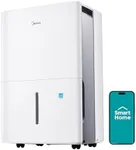Buying Guide for the Best Dehumidifiers
Choosing the right dehumidifier can make your home more comfortable, protect your belongings, and even improve your health by reducing excess moisture in the air. The best dehumidifier for you depends on the size of the space you want to treat, the typical humidity levels, and how you plan to use the device. Understanding the key specifications will help you find a model that fits your needs and works efficiently in your environment.Capacity (Pint Removal per Day)Capacity refers to how much moisture a dehumidifier can remove from the air in a 24-hour period, usually measured in pints. This is important because it determines how effective the unit will be in your space. Smaller capacities (20-30 pints) are suitable for small rooms or mildly damp areas, medium capacities (30-50 pints) work well for average-sized rooms or moderately damp spaces, and larger capacities (50+ pints) are best for basements, large rooms, or very damp environments. To pick the right one, consider both the size of the area and how wet it tends to get—bigger, damper spaces need higher capacity.
Room Size CoverageRoom size coverage tells you the maximum area the dehumidifier is designed to handle, usually given in square feet. This is important because using a unit that's too small for your space will make it work harder and less efficiently. Coverage is often divided into small (up to 300 sq. ft.), medium (300-700 sq. ft.), and large (over 700 sq. ft.) spaces. Measure your room and match it to the dehumidifier's recommended coverage to ensure effective moisture removal.
Water Tank CapacityThe water tank capacity is the amount of water the dehumidifier can hold before it needs to be emptied. This matters because a small tank will fill up quickly and require frequent emptying, while a larger tank allows for longer operation between emptying. Tanks typically range from about 1 to 2 gallons. If you want less maintenance, look for a larger tank or a model with a continuous drain option.
Drainage OptionsDrainage options refer to how the collected water is removed from the dehumidifier. Some models require manual emptying of the tank, while others offer a hose connection for continuous drainage. This is important for convenience, especially if you plan to run the dehumidifier for long periods or in a hard-to-reach area. If you don't want to empty the tank often, choose a model with a continuous drain feature.
Humidistat and ControlsA humidistat lets you set your desired humidity level, and the dehumidifier will automatically turn on or off to maintain it. This is important for comfort and energy savings. Some models have simple dial controls, while others offer digital displays and precise settings. If you want more control over your indoor environment, look for a model with an adjustable humidistat and easy-to-use controls.
Noise LevelNoise level indicates how loud the dehumidifier is during operation, usually measured in decibels (dB). This matters if you plan to use the unit in a bedroom, living room, or office where quiet is important. Lower noise levels (below 50 dB) are best for quiet spaces, while higher levels may be acceptable in basements or utility rooms. Consider where you'll use the dehumidifier and choose a noise level that won't disturb you.
Energy EfficiencyEnergy efficiency tells you how much electricity the dehumidifier uses to remove moisture. This is important for keeping your energy bills low, especially if you plan to run the unit often. Look for models with an Energy Star rating or similar efficiency certifications, as these use less power for the same performance. If you care about long-term operating costs, prioritize energy-efficient models.
Portability and SizePortability and size refer to how easy it is to move and fit the dehumidifier in your space. Some units have wheels and handles for easy movement, while others are more compact for tight spaces. If you need to move the dehumidifier between rooms or have limited space, look for a lightweight, portable model with convenient features.















